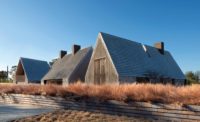Mexican Beach House by BAAQ'
Puerto Escondido, Mexico

The beach house is composed of four volumes of wood and concrete. Photo © Edmund Sumner
Architects & Firms
A vacation house that Mexico City architect Alfonso Quiñones built for his family offers an intriguing low-budget—if slightly idiosyncratic—solution to outdoor living. Quiñones, whose office is named BAAQ’ , designed a cluster of four detached slatted-wood volumes organized around a courtyard and pool for his four children, wife, and himself. Totaling 2,600 square feet of interior space, the compound sits on a 7,500-square-foot property fronting a rocky beach on the Pacific Ocean, six hours by car from Oaxaca and about half an hour from the town of Puerto Escondido.
The separate structures all offer easy access to the outdoors and good sight lines through the compound to the ocean, along with a sense of privacy to the occupants, Quiñones explains. Each of the four pavilions’ ground floors accommodates a different programmatic space, such as the kitchen, the living room, and a study, while bedrooms occupy the levels above. One cabin contains bedrooms on both floors.

1

2
Folding panels open onto the rocky Pacific beach (1). The cluster is arranged around an open courtyard (2). Photos © Edmund Sumner, click to enlarge.
In constructing this rustic retreat, which cost $280,000, the architect took interesting shortcuts: “You don’t need windows to see the ocean from inside the house,” he says. The reason: he clad the pine-frame structure in louvers made from the trunks of palm trees. By artfully arranging the reed-like stems of “palm bone,” as he calls it, Quiñones created gaps for ventilation and views. Wood folding panels provide physical as well as visual access, while spindly canopies projecting from the huts offer shade.

3
Ladderlike stairs (3) connect the levels. An upstairs bedroom overlooks a double-height studio/ bedroom (4). Photos © Edmund Sumner

4
Although he used reinforced concrete for low structural walls and the plinth, the architect has favored natural materials. Parts of a large parota tree form a bridge across the pool; remaining pieces reappear as tables and chairs. Earth and clay cover the floors on the first level. For a house that depends on mosquito netting instead of glass, this is hardly el grande mansion by the sea. “It’s not that kind of statement,” says Quiñones, who named the house Naila after a romantic folk song.
Click plans to enlarge






